Six ways Knight Rider predicted the future
- Published
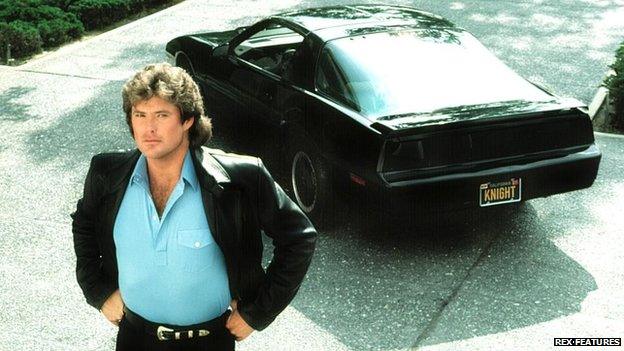
Michael Knight, as played by David Hasselhoff, with Kitt - the futuristic car (and star of the show)
There can perhaps be no greater honour for sci-fi writers than to create worlds that they eventually see come true.
For Knight Rider creator Glen Larson, who has died aged 77, he will have at least seen some, if sadly not all, of his imaginations become reality.
The show's tagline, uttered over that irresistible theme tune, declares the show "a shadowy flight into the dangerous world of a man who does not exist".
Like David Hasselhoff's Michael Knight character, much of the technology found under the bonnet of Knight Industries Two Thousand - Knight's car, known simply as Kitt - didn't exist.
At least, not in 1982.
Here are some of the most memorable - many of which are found in many cars on the road today.

Self-driving/Auto collision avoidance

Many companies have now incorporated sophisticated collision detection into their vehicles
Michael Knight normally had a lot on his plate, and so it was generally useful to be able to palm off some simple tasks - like driving - to Kitt.
To prevent the obvious pitfall of crashing into things, Kitt would deploy auto collision avoidance technology. The car would scan what was happening around it to make sure it reacted quickly.
Twenty years later, auto collision detection technology is a widely implemented safety feature. The European Commission has said that by 2015, all new commercial vehicles should be fitted with devices that could, they hope, dramatically decrease the number of fatalities on European roads.
Ford, GM, Toyota and many others are funding huge swathes of research and development in the area.
When to see it: Episode 108, Trust Doesn't Rust

Anamorphic equaliser
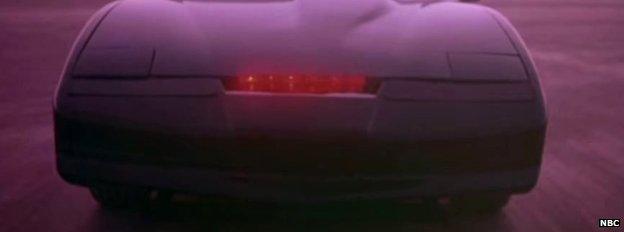
The anamorphic equaliser was able to see with X-ray vision
Perhaps Kitt's most distinctive feature was the red bar of light that would ebb and flow on the front of the car.
Aside from merely looking good, it was actually carrying out an important function - the anamorphic equaliser was described by the programme-makers as a series of "electronic eyes".
It allowed Kitt, and therefore Knight, to see in X-ray vision or infra-red.
Unfortunately, the bar was also thought to be Kitt's weakest point, its Achilles heel, because it was not protected by the car's bulletproof armour.
In this regard, modern day technology hasn't quite reached the heights of Kitt - yet.
The likes of Mercedes Benz have fitted some of their higher-end vehicles with technology that allows the driver to see better in the dark (other than, obviously, turning on lights). Using infra-red, the road ahead is "lit up" in a way that is invisible to humans, but can be interpreted by a computer to give better visibility.
Other systems use thermal radiation given off by animals and humans to allow a different way to "see" in the dark.
When to see it: Throughout the series

Homing device

Google says it expects its self-drive cars to be on the road "within a year"
If Knight was struggling, and needed Kitt, he could summon the car via a homing beacon hidden in a gold pendant he kept around his neck. Kitt would roar into life and come and rescue him.
Today, Google's vision of a future of driverless cars has a similar feature. Instead of a gold pendant, the car is summoned via a person's smartphone.
And Google's cars won't exactly rush to your side - with a top speed, for the time being, of 25mph. Much more sensible, but far less cool.
When to see it: Episode 218, A Good Knight's Work

Medical scanner
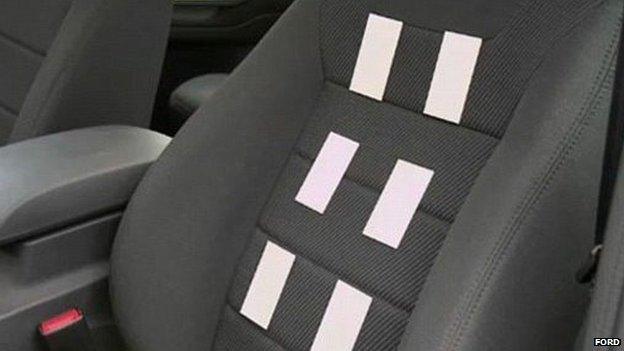
Sensors in Ford's car seat can monitor the rider's heart rate
It's no good Kitt being highly advanced if the man it's supposed to protect is, well, dead. And so one of the first futuristic features we're shown on Knight Rider is Kitt's ability to detect Knight's vital signs.
The car can tell if someone riding in it is "injured, poisoned, undergoing stress or other emotional behaviour". How did it get this information? Why through the seat of course!
Step forward Ford, with its ECG Heart Rate Monitoring Seat. Six embedded sensors are able to monitor vital signs and detect whether a driver is, for example, having a heart attack.
If a problem is detected, the chair could activate the car's other safety features - like collision avoidance - to bring the vehicle to a slow stop.
When Kitt was given an upgrade for a new series in 2008, it was even able to administer help by pumping out extra oxygen.
When to see it: Episode 1, Knight of the Phoenix

Electronic jammer
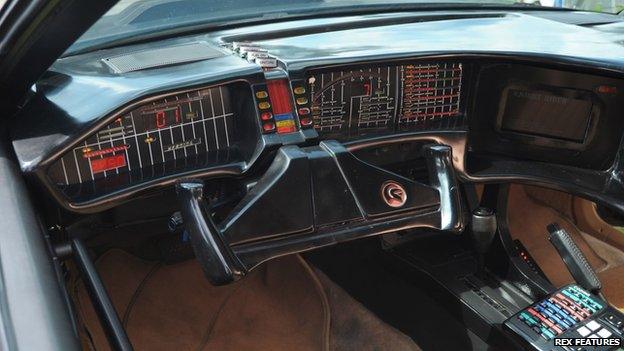
It may look a bit low-tech now - but within Kitt's dashboard was an electronic jammer
Sadly, in the real world, technology isn't always used for the most exciting purpose.
Take jamming, for example. With Kitt, Knight used various forms of electromagnetic or microwave jamming to create serious mischief - moving objects, hacking cash machines to spit out money, and taking control of nearby cars.
In the real world, however, jamming is more likely to be used by truckers to hide what they're up to.
GPS jamming is an increasing concern for traffic authorities the world over - companies use GPS to keep track of where their vehicles are.
Drivers, not fond of the monitoring, and sometimes prone to a spot of moonlighting, have been known to use the £30-a-pop jammers to spoof the system. Not to be recommended (it's illegal, and potentially very dangerous).
When to see it: Episode 109, Inside Out

Hydrogen hybrid
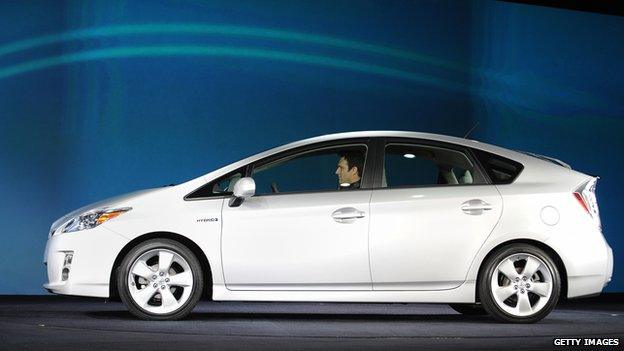
Before the best-selling Toyota Prius, there was... Kitt!
Kitt may have been a loud hulk of a machine - but it was at least environmentally-friendly.
And what powered Knight's brutal turbo engines? Hydrogen, the zero-emission fuel of choice for today's most popular clean cars.
But it didn't just rely on Hydrogen. The car's sophisticated (it's a secret, apparently) engine was able to use a mixture of fuels, including petrol. A hybrid, if you will - just like the Toyota Prius, the car that has become the biggest-selling hybrid globally.
Kitt's fuel efficiency was said to be in the region of 65 miles (100km) per gallon.
When to see it: Throughout the series

Thanks, but no thanks...
Not all the innovations in Kitt have found their way to real-life, and nor would you want them too.
In one episode, Kitt is able to assess the body shape of Bonnie, one of the main female characters, who was wearing overalls.
While in episode 15, we see Knight print out the information he needed, straight from the dashboard.
You'd think, these days, he'd just have it on his phone.
Follow Dave Lee on Twitter @DaveLeeBBC, external
- Published17 November 2014
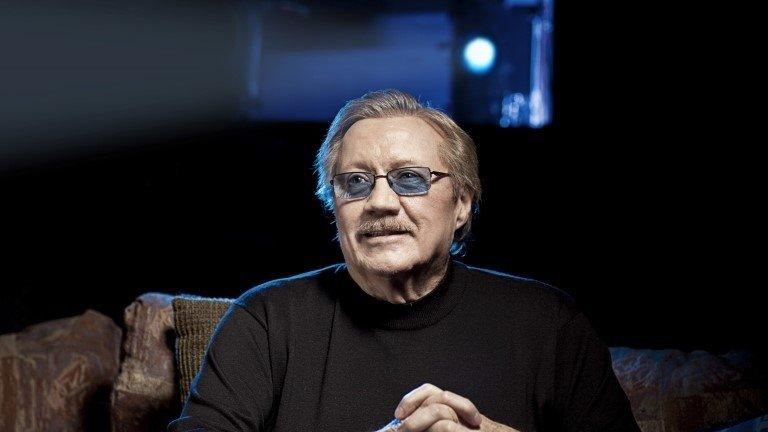
- Published12 November 2014
